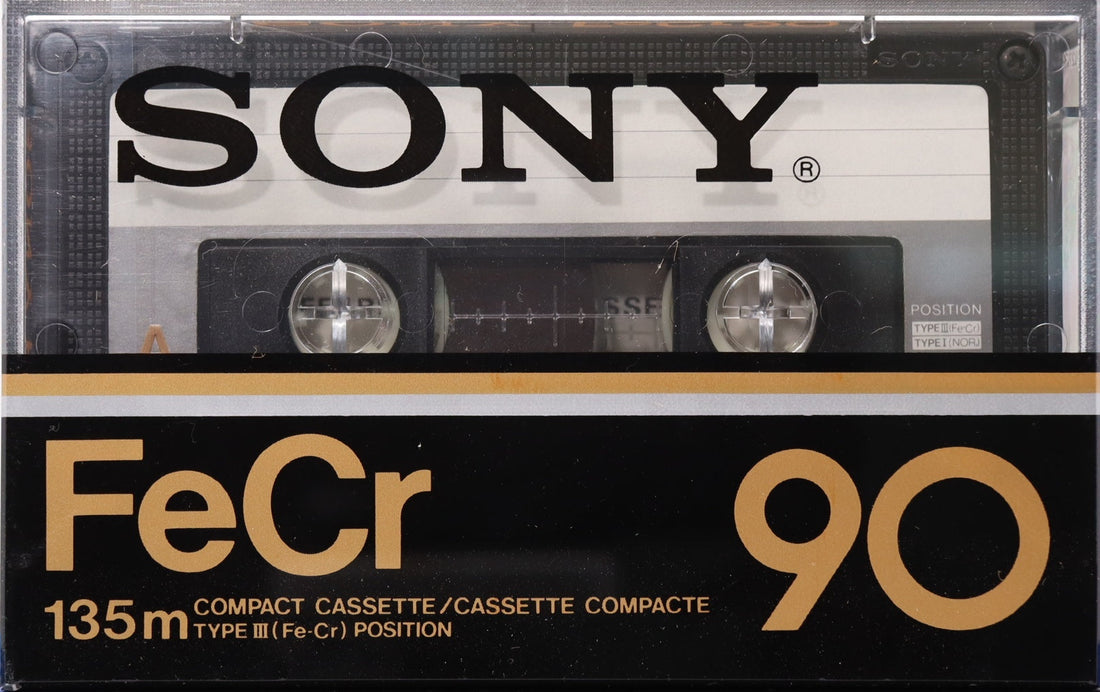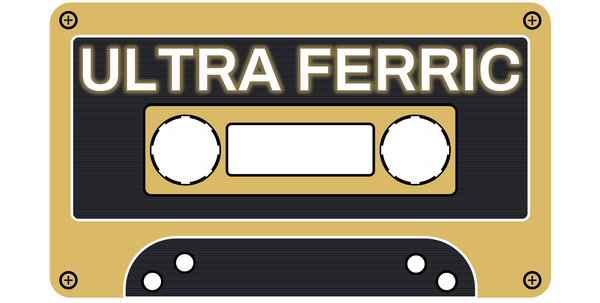
Type III Cassette Tapes: The Forgotten Experiment in Audio History
Share
Cassette tapes have long held a special place in the hearts of audiophiles and collectors, with different tape formulations offering varying levels of sound quality and durability. Among these, Type III cassette tapes, also known as Ferrochrome (FeCr or Ferrichrome) tapes, occupy a unique position in the history of magnetic recording media. Introduced in the early 1970s by Sony, these tapes aimed to combine the best qualities of Type I (ferric oxide) and Type II (chromium dioxide) tapes. Despite their technical advantages, they never achieved widespread commercial success. Let's explore what made Type III cassette tapes special, why they didn't become dominant in the market, and their legacy.
Introduction to Type III Cassette Tapes
Type III cassette tapes featured an innovative design that layered a five-micron ferric base with one micron of CrO2 pigment, promising enhanced low-frequency performance and improved high-frequency clarity. This hybrid composition provided a balance between bass and treble response, making them a technically superior option compared to standard ferric tapes.
Technical Specifications of Type III Tapes
- Composition: A combination of ferric oxide and chromium dioxide, leveraging the benefits of both materials.
- Bias Settings: Required a bias setting between normal (Type I) and high (Type II), which was a challenge for many mass-market cassette decks that typically only offered two bias options.
- Noise Level: When recorded with the correct bias, Type III tapes produced a low level of hiss but playing them with incorrect settings resulted in higher noise levels.
Do Type III Cassettes Require a Special Deck?
One of the significant barriers to the success of Type III tapes was the need for specialized playback equipment. Most commercial cassette decks only supported Type I and Type II tapes, with few offering the necessary bias adjustments for Type III tapes. This meant that users needed a deck with adjustable bias settings to fully utilize the capabilities of type III tapes, which was not common in consumer-grade equipment. The lack of widespread compatibility made it difficult for these tapes to gain traction in the market.
While some still claim you can use type III tapes even on cassette decks that do not support them natively, be aware that doing so will significantly limit the performance you can get compared to using them with a cassette deck that does support type III natively.
Bias Settings and Sound Quality
The bias settings of Type III tapes significantly affected their sound quality. Because these tapes required a bias setting between normal and high, neither of the standard bias options was optimal. If recorded with the correct bias, Type III tapes offered a balanced sound with improved bass and treble clarity. However, using incorrect bias settings resulted in a less refined sound with increased noise levels. This complexity made them less appealing to consumers who preferred simpler options.
Attempts to Improve Type III Tapes
There were no significant attempts to improve Type III tapes after their initial failure. The main manufacturers, such as Sony, BASF, Scotch, and Agfa, continued to produce these tapes until the mid-1980s, but no major revisions or improvements were made to address the issues of complexity and compatibility. The market's shift towards the superior type IV metal tapes and Ferricobalt (both type I and type II) formulations overshadowed any potential for reviving Type III tapes.
The Main Benefits of Type III Cassette Tapes
Despite their commercial struggles, Type III tapes had several technical advantages that made them an appealing choice for audiophiles and professional users:
- Type III tapes combined the strengths of both ferric and chrome formulations, delivering improved high-frequency response compared to standard ferric tapes while retaining better low-end warmth than chrome tapes.
- The Ferro-Chrome composition reduced background hiss compared to Type I tapes, resulting in clearer recordings with higher fidelity.
- Type III tapes exhibited better magnetic stability, which meant recordings were less prone to degradation over time compared to standard ferric tapes.
- With enhanced midrange clarity and a good balance between bass and treble, Type III tapes offered a dynamic listening experience ideal for both music and spoken-word recordings.
- By incorporating ferric oxide, these tapes offered better low-frequency performance compared to Type II tapes.
- The addition of chromium dioxide provided improved high-frequency definition, like Type II tapes.
- While Type III tapes were not specifically tailored for any particular music genre, their balanced sound profile made them suitable for a wide range of music. However, genres that emphasize both bass and treble clarity, such as jazz or classical music, might have benefited from the unique characteristics of Type III tapes.
Despite their technical advantages, Type III tapes failed to gain significant market traction. Several factors contributed to this:
- Unlike Type I and Type II tapes, which became widely supported by manufacturers, Type III never gained broad industry adoption. Many cassette decks simply lacked the necessary FeCr bias setting, limiting their usability.
- By the time Type III tapes were introduced, Type II (Chrome) tapes were already well-established, and shortly afterward, Type IV (Metal) tapes entered the market with even better performance. Consumers and manufacturers were hesitant to embrace yet another format.
- Because of their niche status, Type III tapes were produced in smaller quantities and were often more expensive than their more common counterparts. This further discouraged widespread consumer adoption.
- Ferrichrome tapes were more expensive than their counterparts, making them less attractive to the average consumer who prioritized affordability over incremental audio quality improvements.
- Unlike Type I, II, and IV tapes, which were heavily promoted by major brands, Type III tapes never received the same level of marketing support. Many consumers were unaware of their advantages or simply saw them as unnecessary.
- The failure of Type III tapes did not significantly affect consumer confidence in cassette technology. Consumers continued to use cassettes, and the introduction of superior technologies, like Type IV metal tapes, maintained interest in cassette technology. However, the failure of Type III tapes did highlight the importance of compatibility and simplicity in consumer electronics, influencing future product development.
- Tape deck manufacturers stopped supporting Type III tapes primarily due to their limited market demand and the complexity of the required bias settings. By 1983, manufacturers ceased providing options for recording Type III tapes, as the market shifted towards more popular and simpler formats.
Conclusion
Type III cassette tapes were an ambitious attempt to bridge the gap between ferric and chrome formulations, offering a balance of warmth, clarity, and reduced noise. However, their requirement for specialized playback equipment, combined with strong competition from Type II and Type IV tapes, ultimately led to their commercial demise. Still, for those who appreciate the nuances of vintage audio, Type III tapes remain a fascinating relic worth exploring. As we continue to appreciate the analog audio era, Type III tapes serve as a reminder of the relentless pursuit of sound quality that defined the cassette tape revolution.


